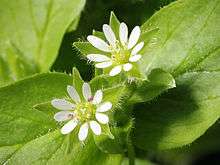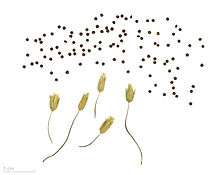Stellaria media
| Common chickweed | |
|---|---|
 | |
| Flowers of the common chickweed | |
| Scientific classification | |
| Kingdom: | Plantae |
| (unranked): | Angiosperms |
| (unranked): | Eudicots |
| (unranked): | Core eudicots |
| Order: | Caryophyllales |
| Family: | Caryophyllaceae |
| Genus: | Stellaria |
| Species: | S. media |
| Binomial name | |
| Stellaria media (L.) Vill. | |
| Synonyms | |

Stellaria media, chickweed, is a cool-season annual plant native to Europe, but naturalized in many parts of North America. It is used as a cooling herbal remedy, and grown as a vegetable crop and ground cover for both human consumption and poultry. It is sometimes called common chickweed to distinguish it from other plants called chickweed. Other common names include chickenwort, craches, maruns, winterweed. The plant germinates in autumn or late winter, then forms large mats of foliage.
Description
The plants are annual and with weak slender stems, they reach a length up to 40 cm. Sparsely hairy, with hairs in a line along the stem. The leaves are oval and opposite, the lower ones with stalks. Flowers are white and small with 5 very deeply lobed petals. The stamens are usually 3 and the styles 3.[1] The flowers are followed quickly by the seed pods. This plant flowers and sets seed at the same time.
Distribution and identification
Stellaria media is widespread in North America, Europe and Asia. There are several closely related plants referred to as chickweed, but which lack the culinary properties of plants in the genus Stellaria. Plants in the genus Cerastium are very similar in appearance to Stellaria and are in the same family (Caryophyllaceae). Stellaria media can be easily distinguished from all other members of this family by examining the stems. Stellaria has fine hairs on only one side of the stem in a single band and on the sepals.[1] Other members of the family Caryophyllaceae which resemble Stellaria have hairs uniformly covering the entire stem. It usually has 3 stamens[1] other references indicate 5 stamens[2] and 3 - 8 in other references.[3]
Habitat
Very common as a weed in waste places.[4][5]
Ecology
The larvae of the European moth yellow shell (Camptogramma bilineata), of North American moths pale-banded dart (Agnorisma badinodis) or dusky cutworm (Agrotis venerabilis) or North American butterfly dainty sulphur (Nathalis iole) all feed on chickweed.
Growth
In both Europe and North America this plant is common in gardens,[6] fields, and disturbed grounds. Control is difficult due to the heavy seed sets. Common chickweed is very competitive with small grains, and can produce up to 80% yield losses among barley.[7]
Uses
As food
Stellaria media is edible and nutritious, and is used as a leaf vegetable, often raw in salads.[8] It is one of the ingredients of the symbolic dish consumed in the Japanese spring-time festival, Nanakusa-no-sekku.
Toxicity
S. media contains plant chemicals known as saponins, which can be toxic when consumed in large quantities. Chickweed has been known to cause saponin poisoning in cattle. However, as the animal must consume several kilos of chickweed in order to reach a toxic level, such deaths are rare.
In folk medicine
The plant has medicinal purposes and is used in folk medicine. It has been used as a remedy to treat itchy skin conditions and pulmonary diseases.[9] 17th century herbalist John Gerard recommended it as a remedy for mange. Modern herbalists prescribe it for iron-deficiency anemia (for its high iron content), as well as for skin diseases, bronchitis, rheumatic pains, arthritis and period pain.[10] Not all of these uses are supported by scientific evidence.[11] The plant was used by the Ainu for treating bruises and aching bones. Stems were steeped in hot water before being applied externally to affected areas.[12]
Chemistry
The anthraquinones emodin, parietin (physcion) and questin, the flavonoid kaempferol-3,7-O-α-L-dirhamnoside, the phytosterols β-sitosterol and daucosterol, and the fatty alcohol 1-hexacosanol can be found in S. media.[13] Other flavonoid constituents are apigenin 6-C-beta-D-galactopyranosyl-8-C-alpha-L-arabinopyranoside, apigenin 6-C-alpha-L-arabinopyranosyl-8-C-beta-D-galactopyranoside, apigenin 6-C-beta-D-galactopyranosyl-8-C-beta-L-arabinopyranoside, apigenin 6-C-beta-D-glucopyranosyl-8-C-beta-D-galactopyranoside, apigenin 6, 8-di-C-alpha-L-arabinopyranoside.[14] The plant also contains triterpenoid saponins[15][16] of the hydroxylated oleanolic acid type.[17] Proanthocyanidins are present in the testa of seeds.[18]
Etymology
Stellaria is derived from the word 'stellar' meaning 'star', which is a reference to the shape of its flowers. Media is derived from Latin and means 'between', 'intermediate', or 'mid-sized'.[19]
See also
References
Notes
- 1 2 3 Parnell, J. and Curtis, T. 2012. Webb's An Irish Flora. Cork University Press. ISBN 978-185918-4783
- ↑ Martin, W. Keble, 1965. The Concise British Flora in Colour. George Rainbird Ltd
- ↑ Clapham, A.R., Tutin, T.G. and Warburg, E.F. 1968. Excursion Flora of the British Isles. Cambridge Press. ISBN 0-521-04656-4
- ↑ Hackney, P. (ed) 1992. Stewart and Corry's Flora of the North-east of Ireland. Institute of Irish Studies, The Queen's University of Belfast. ISBN 0-85389-446-9(HB)
- ↑ Webb, D.A. Parnell, J. and Doogue, D. 1996. An Irish Flora. Dundalgan Press (W.Tempest) Ltd. ISBN 0-85221-131-7
- ↑ Neltje, Blanchan (2005). Wild Flowers Worth Knowing. Project Gutenberg Literary Archive Foundation.
- ↑ A. Davis, K. Renner, C. Sprague, L. Dyer, D. Mutch (2005). Integrated Weed Management. MSU.
- ↑ Stellaria media at Plants for a Future
- ↑ Hensel, Wolfgang (2008). Medicinal plants of Britain and Europe. London: A&C Black. ISBN 9781408101544.
- ↑ Wiest, Renee. "Chickweed". hartonweb.com. Good Health Herbs. Retrieved 15 Dec 2015.
- ↑ Howard, Michael (1987). Traditional folk remedies : a comprehensive herbal. London: Century. p. 119. ISBN 0-7126-1731-0.
- ↑ Batchelor, J. and Miyabe, K. (n.d.). Ainu economic plants. 1st ed. 1893.
- ↑ Studies on the Chemical Constituents From Stellaria media (II). Huang Yuan, Dong Qi, Qiao Shan-Yi, Pharmaceutical Journal of Chinese People's Liberation Army, 2007-03 (abstract) (Article in Chinese)
- ↑ Dong, Q; Huang, Y; Qiao, SY (2007). "Studies on chemical constituents from stellaria media. I". Zhongguo Zhong yao za zhi = Zhongguo zhongyao zazhi = China journal of Chinese materia medica (in Chinese). 32 (11): 1048–51. PMID 17672340.
- ↑ Hu, Y.M.; Wang, H.; Ye, W.C.; Qian, L. (2009). "New triterpenoid fromStellaria media(L.) Cyr". Natural Product Research. 23 (14): 1274–8. PMID 19735039. doi:10.1080/14786410701642532.
- ↑ Weng, A; Thakur, M; Beceren-Braun, F; Gilabert-Oriol, R; Boettger, S; Melzig, MF; Fuchs, H (2012). "Synergistic interaction of triterpenoid saponins and plant protein toxins". Planta Medica. 78 (11). doi:10.1055/s-0032-1320271.
- ↑ Böttger, Stefan; Melzig, Matthias F. (2011). "Triterpenoid saponins of the Caryophyllaceae and Illecebraceae family". Phytochemistry Letters. 4 (2): 59. doi:10.1016/j.phytol.2010.08.003.
- ↑ Bittrich, V.; Amaral, Maria Do Carmo E. (1991). "Proanthocyanidins in the testa of centrospermous seeds". Biochemical Systematics and Ecology. 19 (4): 319. doi:10.1016/0305-1978(91)90020-Z.
- ↑ Gledhill, David (2008). "The Names of Plants". Cambridge University Press. ISBN 9780521866453 (hardback), ISBN 9780521685535 (paperback). pp 253, 361
Further reading
- Everitt, J.H.; Lonard, R.L.; Little, C.R. (2007). Weeds in South Texas and Northern Mexico. Lubbock: Texas Tech University Press. ISBN 0-89672-614-2
- Tilford, Gregory L. (1997). Edible and Medicinal Plants of the West. Mountain Press Publishing Company. ISBN 0-87842-359-1.
External links
| Wikispecies has information related to: Stellaria media |
| Wikimedia Commons has media related to Stellaria media. |
| Wikiversity has bloom time data for Stellaria media on the Bloom Clock |